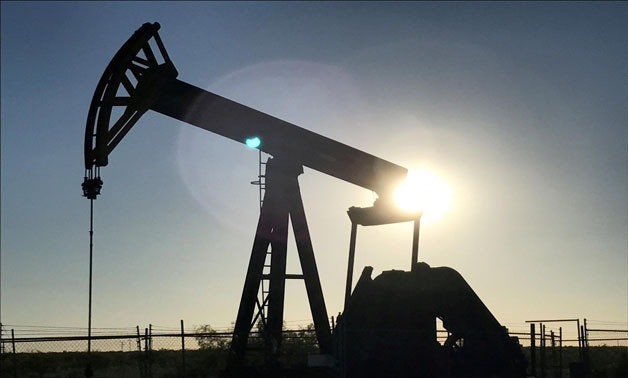
An oil pump is seen operating in the Permian Basin near Midland, Texas, U.S. on May 3, 2017. Picture taken May 3, 2017 - REUTERS/Ernest Scheyder/File Photo
CAIRO – 4 March 2018: Egypt’s Petroleum Ministry achieved around 800 new oil and gas discoveries starting fiscal year (FY) 2001/02 and until 2015/16.
During this period, the ministry achieved 520 crude oil discoveries, according to figures from state statistics agency CAPMAS.
Fiscal years 2011/12 and 2012/13 saw the largest crude oil discoveries, with an average of 57 discoveries each year, followed by FY 2013/14 with an average of 41 discoveries.
In its recently launched report “Egypt in Figures 2018”, CAPMAS showed that FY 2015/16 saw the smallest amount of discoveries.
As for gas discoveries, fiscal years 2007/08 and 2012/13 saw the biggest gas discoveries, realizing 26 and 29 discoveries respectively.
The giant offshore Zohr gas field is one of the most significant gas discoveries in Egypt and the Mediterranean region.
Discovered by Italian energy company ENI in 2015, Zohr gas field has an area of 100 square meters and a depth of 1,450 meters.
Eni in December delivered the first gas from Zohr field, whose estimated 30 trillion cubic feet (tfc) makes it the biggest gas field in the Mediterranean.
Minister of Petroleum Tarek el-Molla told Reuters Sunday that Egypt aims to increase production at Zohr gas field to 700 million cubic feet per day in May, up from about 350 million cubic feet per day.
Production from the field is expected to increase gradually until it reaches around 1.7 billion cubic feet a day by the end of 2018 and to 2.7 billion cubic feet per day in 2019.
 Photo courtesy of Egypt in Figures 2018 report
Oil and gas production
Photo courtesy of Egypt in Figures 2018 report
Oil and gas production
Egypt produced around 626,000 crude oil barrels and condensates a day in FY 2016/17. According to the Petroleum Ministry, the Western Desert area contributes 55 percent to total production, the CAPMAS report showed.
The Egyptian General Petroleum Corporation (EGPC) plans to increase its production from petroleum products to reach some 670,000 barrels in 2017/18.
Molla said that the gap between Egypt’s local production and consumption of petroleum products amounts to 35 percent, which will be filled in the coming three years through the expansion of refineries and imports. He added that rationalizing energy subsidies will help in curbing consumption.
Meanwhile, Egypt’s natural gas production amounts to 5.5 billion cubic feet a day. The Egyptian Natural Gas Holding Company (EGAS) targets to boost production to more than six billion cubic feet, in addition to halting gas imports and achieving natural gas self-sufficiency by the end of 2018.
Egypt plans to stop importing liquefied natural gas (LNG) by the end of the 2017/18 fiscal year ending in June as it accelerates production at a number of newly-discovered gas fields, Molla said in January.
Egypt’s natural gas production will reach some six billion cubic feet a day by the end of fiscal year 2017/18, Deputy Chairman of the Egyptian Natural Gas Holding Company (EGAS) for production and fields’ development Mohamed Abdel Azim said last month.
Egypt’s gas production currently stands at 5.5 billion cubic feet a day, after adding some 1.6 million cubic feet as a result of starting production from four projects.
The new discoveries are expected to turn Egypt into a net exporter of natural gas as the country is expected to halt gas imports by mid 2018.
Egypt has been intensifying natural gas exploration activities recently. Last month, Egypt’s Ministry of Petroleum signed an agreement with oilfield services company Schlumberger to conduct a seismic survey in the Gulf of Suez.
Molla said that the Suez region is a promising area that requires more work and studies to further discover the oil and gas it possesses.
EGAS announced in February that it will issue a tender for onshore and offshore natural gas exploration in nine blocks.
The tender, which includes six offshore and three onshore blocks, will be issued before June 2018.
EGAS has put a plan to issue tenders for natural gas exploration annually, especially in the Mediterranean, which the company considers as a promising area for natural gas.

Comments
Leave a Comment